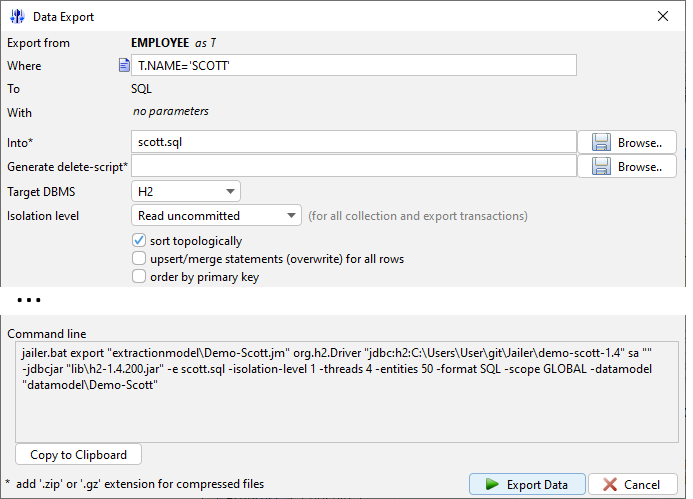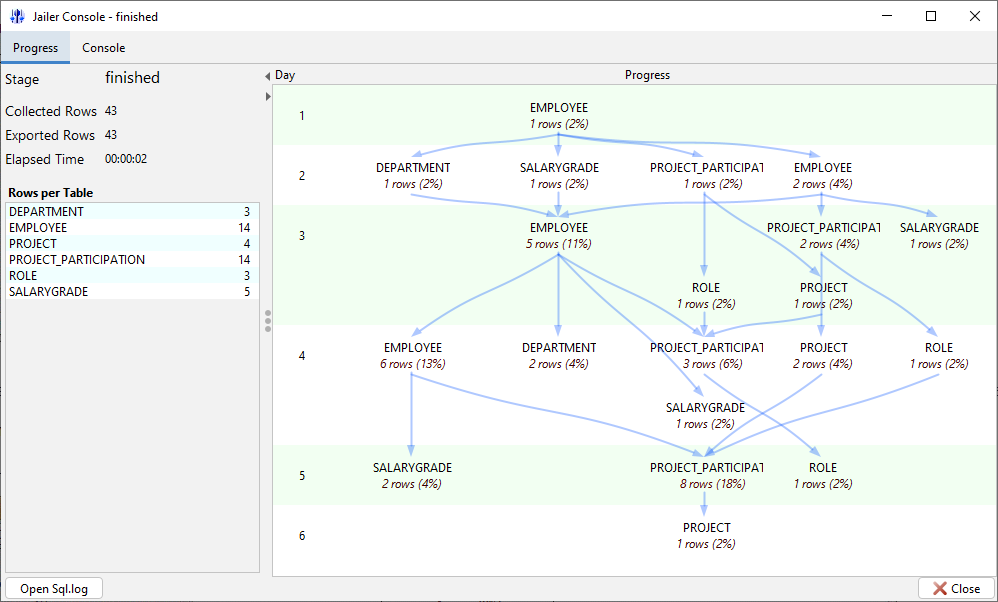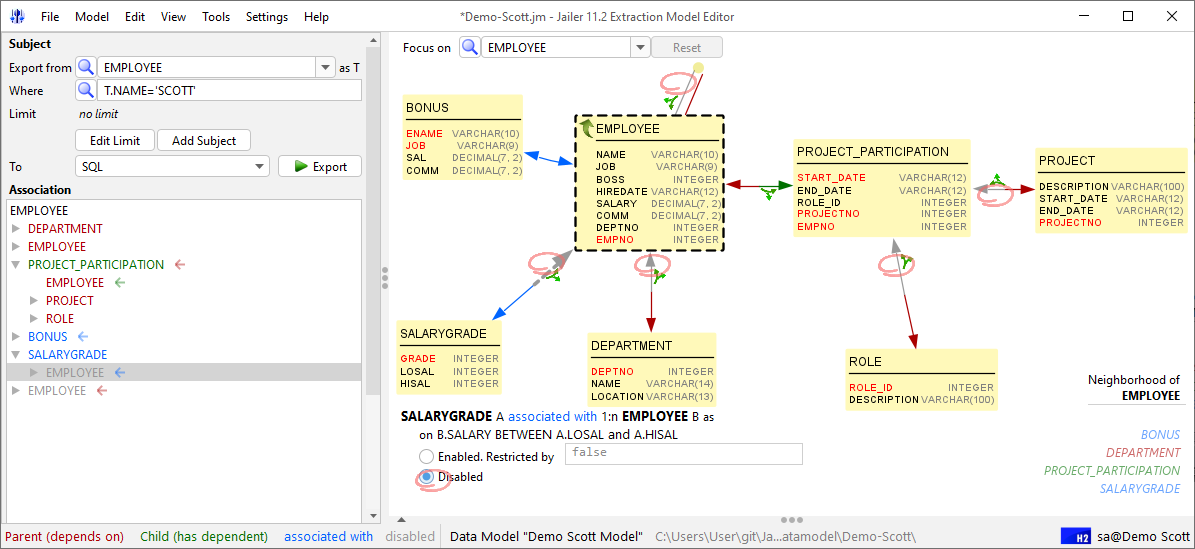Database Subsetting With Jailer
In this tutorial, you will learn how to export consistent sets of rows from relational databases to topologically sorted SQL-DML.
Join the DZone community and get the full member experience.
Join For FreeJailer is a great tool to consider for database subsetting, schema, and data browsing. It creates small slices from your database and lets you navigate through it by following the relationships. Jailer is ideal for creating small test data samples or for local problem analysis with relevant production data.
A Quick Look at Jailer's Features
- The Data Browser lets you navigate through your database, following the relationships (foreign key-based or user-defined) between tables.
- The Subsetter creates small slices from your productive database and imports the data into your development and test environment (consistent and referentially intact).
- The tool improves database performance by removing and archiving obsolete data without violating integrity.
- It generates SQL (topologically sorted), JSON, YAML, XML (hierarchically structured), and DbUnit datasets.
-
A demo database is included, and you can get a first impression without any configuration effort.
How to Export Related Data Using Jailer
In this tutorial, you will learn how to export consistent sets of rows from relational databases into topologically sorted SQL-DML, i.e., a sequence of INSERT statements ordered in a way that no foreign-key constraint will be violated during execution.
In the following scenario, we will export all the data related to the employee named 'Scott' into an SQL script.
Step 1: Setup the Database
Use the demo data model, Demo Scott.
Step 2: Export Employee Scott (Unrestricted)
Now, let's try to export the employee named Scott. To do that, we need an extraction model.
Select EMPLOYEE as a table to extract and type T. NAME = 'SCOTT' into the 'Where' field:

This extraction model describes a set of entities containing (the) employee(s) named 'SCOTT,' entities associated with these employees, entities associated with these entities, and so forth.
Export this set (Export Data button or Tools -> Export Data). Jailer first asks for a file name for the new extraction model. Call it scott.csv. After that, the Data Export dialogue appears:

Type scott.sql into the first field. This defines the name of the export file to be generated.
Click on Export Data.

The progress panel will then show a generated scott.sql file containing INSERT statements for Scott, his boss, the president, and Scott's department, salary grade, and project participation.
But why are there also statements for all other employees?
Click on "EMPLOYEE" in the "Rows per Table" overview. This displays all process steps leading to additional employee records.

As you can see, all employees assigned to the same department as SCOTT are exported. Likewise, all employees belonging to the same salary grade are exported.
Step 3: Export Employee Scott (Restricted)
Exporting an employee requires exporting his boss and department, too. Otherwise, the set of exported entities would not be consistent (due to the dependencies based on foreign key constraints). No constraint prevents us from excluding the salary grade and the bonus from export, but we don't do that because the resulting set would be incomplete.
On the other hand, we don't want to export all subordinates of an employee or all employees who work in the same department as Scott. To exclude subordinates, department members, and 'same salary-grade' employees, we must restrict some associations.
A restriction is an extension of the association join condition (in SQL syntax) for one direction of an association. Disabled (or false) stands for an unsatisfiable condition.
Apply the following restrictions:
- from DEPARTMENT to EMPLOYEE
- from EMPLOYEE to EMPLOYEE (inverse-BOSS)
- from SALARYGRADE to EMPLOYEE
- from PROJECT to PROJECT_PARTICIPATION
- from ROLE to PROJECT_PARTICIPATION

Go to Tools -> Export Data again. Jailer will now export only the data related to Scott.
-- generated by Jailer
--
-- extraction model: EMPLOYEE where NAME='SCOTT' (extractionmodel/scott.csv)
-- database URL: jdbc:db2://localhost/wisser
-- database user: scott
-- Exported Entities: 13
-- DEPARTMENT 2
-- EMPLOYEE 3
-- PROJECT 2
-- PROJECT_PARTICIPATION 2
-- ROLE 2
-- SALARYGRADE 2
Insert into SALARYGRADE(GRADE, LOSAL, HISAL) values (4, 2001, 3000), (5, 3001, 9999);
Insert into ROLE(ROLE_ID, DESCRIPTION) values (100, 'Developer'), (102, 'Project manager');
Insert into PROJECT(PROJECTNO, DESCRIPTION, START_DATE, END_DATE) values (1001, 'Development of Novel Magnetic Suspension System', '2006-01-01', '2007-08-13'), (1003, 'Foundation of Quantum Technology', '2007-02-24', '2008-07-31');
Insert into DEPARTMENT(DEPTNO, NAME, LOCATION) values (20, 'RESEARCH', 'DALLAS'), (10, 'ACCOUNTING', 'NEW YORK');
Insert into EMPLOYEE(EMPNO, NAME, JOB, BOSS, HIREDATE, SALARY, COMM, DEPTNO) values (7839, 'KING', 'PRESIDENT', null, '1981-11-17', 5000.00, null, 10);
Insert into EMPLOYEE(EMPNO, NAME, JOB, BOSS, HIREDATE, SALARY, COMM, DEPTNO) values (7566, 'JONES', 'MANAGER', 7839, '1981-04-02', 2975.00, null, 20);
Insert into EMPLOYEE(EMPNO, NAME, JOB, BOSS, HIREDATE, SALARY, COMM, DEPTNO) values (7788, 'SCOTT', 'ANALYST', 7566, '1982-12-09', 3000.00, null, 20);
Insert into PROJECT_PARTICIPATION(PROJECTNO, EMPNO, START_DATE, END_DATE, ROLE_ID) values (1003, 7566, '2007-02-24', '2008-07-31', 102);
Insert into PROJECT_PARTICIPATION(PROJECTNO, EMPNO, START_DATE, END_DATE, ROLE_ID) values (1001, 7788, '2006-05-15', '2006-11-01', 100);Conclusion
After going through all the steps and intricacies of Jailer, it is helpful to remember these key points that make it a versatile tool for managing databases:
- Purpose and Functionality: Jailer is a powerful tool specifically designed to efficiently streamline database schemas.
- Key Features: Its standout features include automated database refactoring, seamless data migration, and robust schema evolution support.
- Benefits: It enhances productivity by reducing manual errors, ensuring consistency, and supporting agile development practices.
Opinions expressed by DZone contributors are their own.

Comments